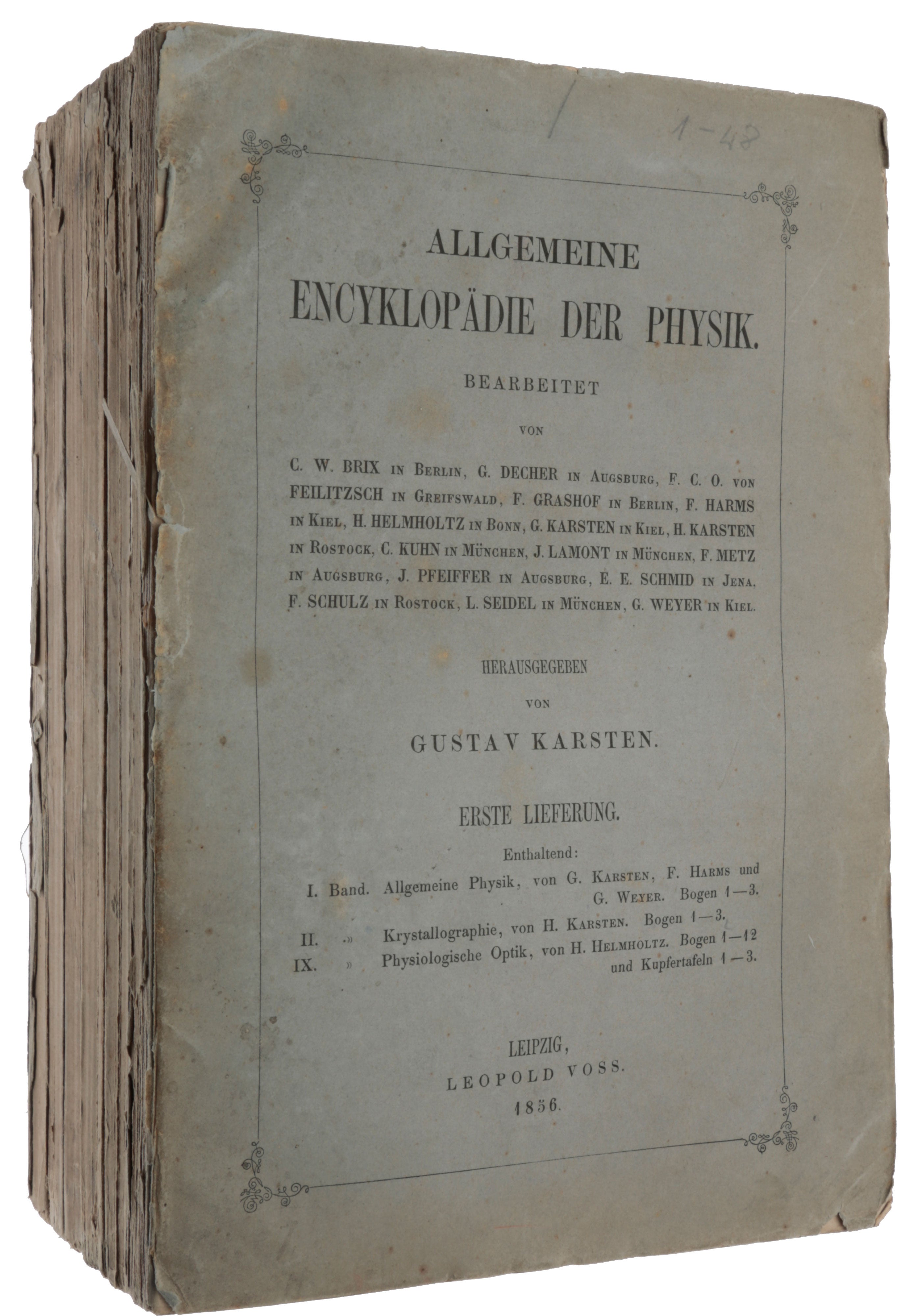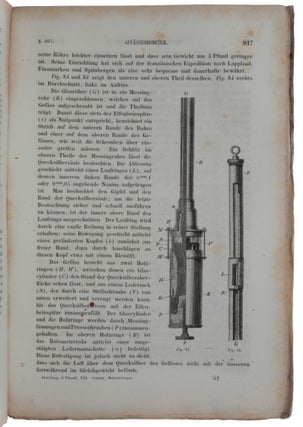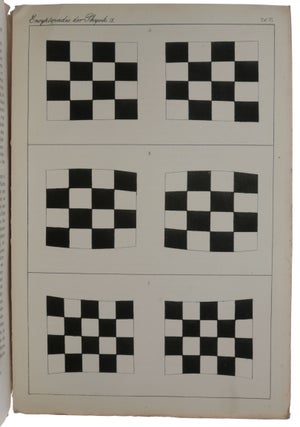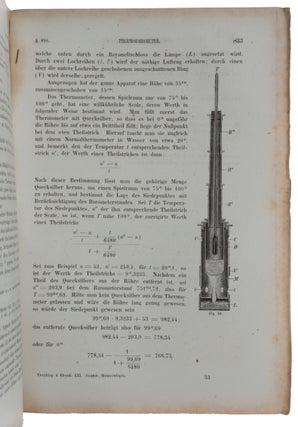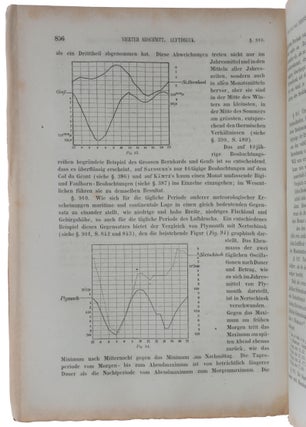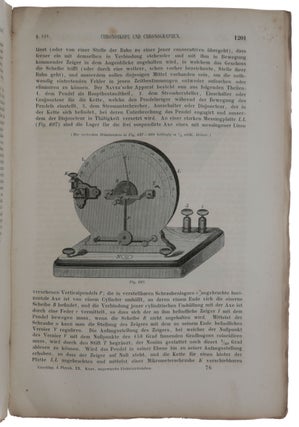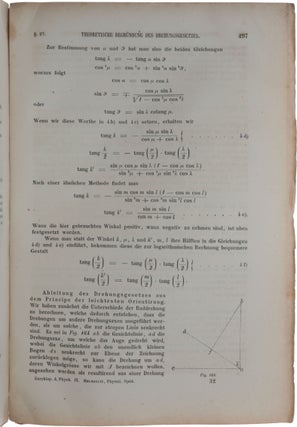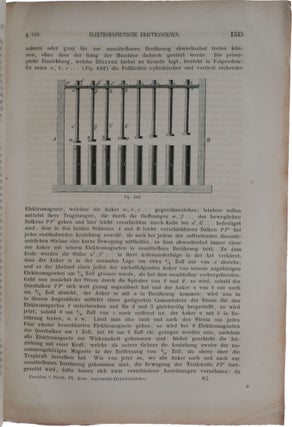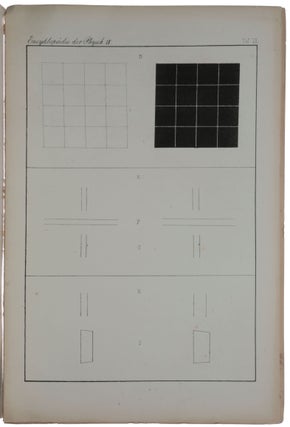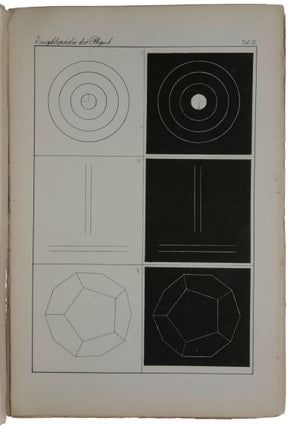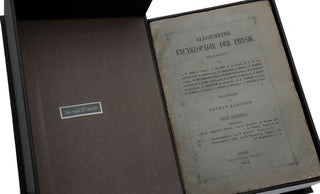Handbuch der physiologischen Optik. Contained in: Allgemeine Encyklopädie der Physik, Bd. IX, Lieferungen 1, 7, 8, 17, 18, 19.
Leipzig: Leopold Voss, 1856-60-66-67. First edition, and the only recorded copy in the original parts, of “the most important book on the physiology and physics of vision” (Grolier/Horblit), and “one of the greatest books on physiological optics” (Garrison-Morton). This work encompassed all previous research in the field, including the results of Helrnholtz’s work in optics: his study of colours, and his investigations of the physiology of vision and the dioptrics of the eye, enterprises aided by his invention of the ophthalmoscope and the ophthalmometer. “Volume I, which appeared in 1856, contained a detailed treatment of the dioptrics of the eye . . . In it Helmholtz treated the various imperfections of the lens system and announced the result that the visual axis of the eye does not correspond to its optical axis. Volume I also elaborated Helmholtz’s theory of accommodation and his invention of the ophthalmometer, both announced in 1855. In Volume II Helmholtz introduced [Thomas] Young’s theory [of colour vision], calling it a special application of Johannes Muller’s law of specific nerve energies. He also dealt with the complex phenomena of irradiation, after-images and contrast, which had dominated the interest of German physiologists since Goethe’s Farbehlehre” (DSB). In Part I Helmholtz is principally concerned with the problem of the refraction of the light-rays, or the dioptrics of the eye. Part II deals with the theory of visual sensations and treats first the various forms of stimulation of the optic nerve, and of its excitation by light in particular, after which Helmholtz gives a connected development of the theories previously published by himself and others on simple and compound colours. Part III deals with the connections between the sensations and external objects, that is with the representations of objects by the perceptions caused by them, which leads to the question of what kind of truth are we to ascribe to our ideas and perceptions. “Helmholtz published two works of major importance. First is his Handbook of Physiological Optics, in which he concentrated on his research on vision and visual perception. This work contained the essentials of his physiological doctrine and threw light on the way in which he conceived the complex relationships of physiology with philosophy and logic” (Muelders, p. xvii). Helmholtz’s Handbuch was first issued as Volume IX of the Allgemeine Encyklopädie der Physik, and appeared in 6 fascicles. This is the only copy we know of in these original parts. The complete work was published in book form in 1867, and that is the form in which it is almost always encountered. Provenance: Harrison D. Horblit (book label inside front cover of clam-shell box). “The years that he spent at Königsberg, from 1851 until his departure for the University of Bonn in 1858, were essentially devoted to research on vision. He published the results regularly in specialized scientific journals, but he also had the good sense to assemble them into a single voluminous Handbook of Physiological Optics, which he re-edited and corrected several times throughout his lifetime and which became a work of reference for several generations of physicians. It contained just about the whole of contemporary knowledge concerning the eye and vision, from anatomy to the psychology of perception. The shadows of Kant and even Fichte were omnipresent because both philosophers were at the very roots of his own concept of perception” (ibid., p. 106). “Helmholtz’s monumental work of more than 1,000 pages is a systematic anthology of all knowledge about vision available at the time. Its genesis was due to a suggestion by one of his friends, Gustav Karsten, who had begun an Encyclopedia of Physics, of which the ninth volume was to be a treatise on optics. The production of Physiological Optics was a long-term enterprise, even more so because its backbone was essentially the author’s own experiments, and he was not always able to maintain the publication rhythm that the editor desired. “The first part was published in 1856, immediately after the author’s arrival in Bonn. Dealing with the dioptrics of the eye, it was dominated by results obtained using the ophthalmoscope and especially the ophthalmometer, a wonderful instrument invented by Helmholtz to make minute measurements of the eye. It enabled him to measure the curvature of the cornea and the variations of distance between it and the iris during accommodation. The second part was only published in 1860, in Heidelberg, and dealt with visual responses to light, simple and composite colors, intensity and duration of visual sensation, and residual images and contrast. The third part, in 1866, dealt essentially with perception of space. “The two first parts constituted an invaluable source of scientific fact derived from research by Helmholtz and his contemporary, or earlier, colleagues. The author clearly derived great satisfaction from using his vast knowledge of physics, geometry, and mathematics. A detailed study of these two parts is of essence highly technical … the third part … related to Helmholtz’s options in terms of scientific methodology and demonstrated the author’s new major intellectual trend toward psychology that had become indispensable for his study of perception. “It began with a long introduction that the author rewrote several times throughout his lifetime, less to update it because of advances in science than to justify his theoretical opinions and refute the objections of his detractors. He developed a general theory of perception in which movement played an essential role. After several chapters devoted to, respectively, eye movements, perception of the direction of gaze and distance, and binocular vision, Helmholtz ended his work with a rather polemical text, in which he presented himself as a crusader for empiricism against innateness and settled some personal scores, notably with his colleague Karl Ewald Hering, the successor of Jan Evangelista Purkinje at the University of Prague” (ibid., pp. 140-1). In his description of this unique copy, Jeremy Norman wrote: “Helmholtz’s Handbuch der physiologischen Optik, was issued as Volume IX of the Allgemeine Encyklopädie der Physik. The Encyklopädie was first published in Lieferungen (fascicles) between 1856 and 1869. Each Lieferung contained parts of two or more works that would eventually form the volumes of the complete Encyklopädie, so that, strangely, each Lieferung of the Encyklopädie containing a portion of Helmholtz’s work also contains a portion of at least one other work. [We might add that one Lieferung may contain parts of more than one volume of the Encyklopädie: for example, the first Lieferung offered here contains parts of vol. I and II as well as vol. IX.] “The Lieferungen containing Helmholtz’s Handbuch are as follows: Erste Lieferung (first fascicle), 1856: Signatures 1-12, plates 1-3 Siebente Lieferung (seventh fascicle), 1860: Signatures 13-21, plates 4-5 Achte Lieferung (eighth fascicle), 1860: Signatures 22-27 Siebzehnte Lieferung (seventeenth fascicle), 1866: Signatures 28-32 Achtzehnte Lieferung (eighteenth fascicle), 1866: Signatures 33-41, plate 6 Neunzehnte Lieferung (nineteenth fascicle), 1867: Signatures 42-56, plus titles and preliminaries, plates 7-11 “Upon completion of the publication of the Encyklopädie each of the Lieferungen would have been broken up and the components assembled into their respective volumes, which accounts for the great rarity of Helmholtz’s Handbuch in the original parts. OCLC records 14 libraries worldwide (Yale and 13 German libraries) that hold complete copies of the Encyklopädie, but it is impossible to determine from these records whether any of the copies is preserved in the original parts. We would suggest that preservation of these institutional sets in the parts is unlikely because the individual works which the Encyklopädie comprises would not make reading sense if left in the fascicles. More than likely, therefore, institutions would have separated the various individual works into separate bindings, thus destroying the fascicles. As far as we have been able to determine, our copy of the Handbuch, which was once owned by renowned science collector Harrison Horblit, is the only recorded copy in the original Lieferungen, and as such it is significant not only for its extreme rarity but for its preservation of the work’s publishing history. “The title-page of the Handbuch is dated 1867 (as it is in the book-form version), but Helmholtz noted in his preface to the work that ‘Die erste Abteilung des vorliegenden Handbuches ist schon im Jahre 1856 erschienen, die zweite 1860, die dritte teils Anfang, teils Ende 1866’ (The first section of this manual was published in 1856, the second in 1860, the beginning of the third part in early and late 1866). Helmholtz explained the long delay in finishing the work as being due to both external circumstances (two changes of residence and the pressures of other scientific work) and internal reasons.” Garrison Morton 1513: Grolier Horblit 49b; Waller 4299; Norman 1046 (all except Horblit for the book edition). Muelders, Helmholtz. From Enlightenment to Neuroscience (Garey, transl. & ed.), 2010.
Six volumes, large 8vo (??? mm), pp. ???? Original printed wrappers (a bit worn and foxed). Preserved in a clam-shell box. Very good.
Item #5275
Price: $32,500.00

